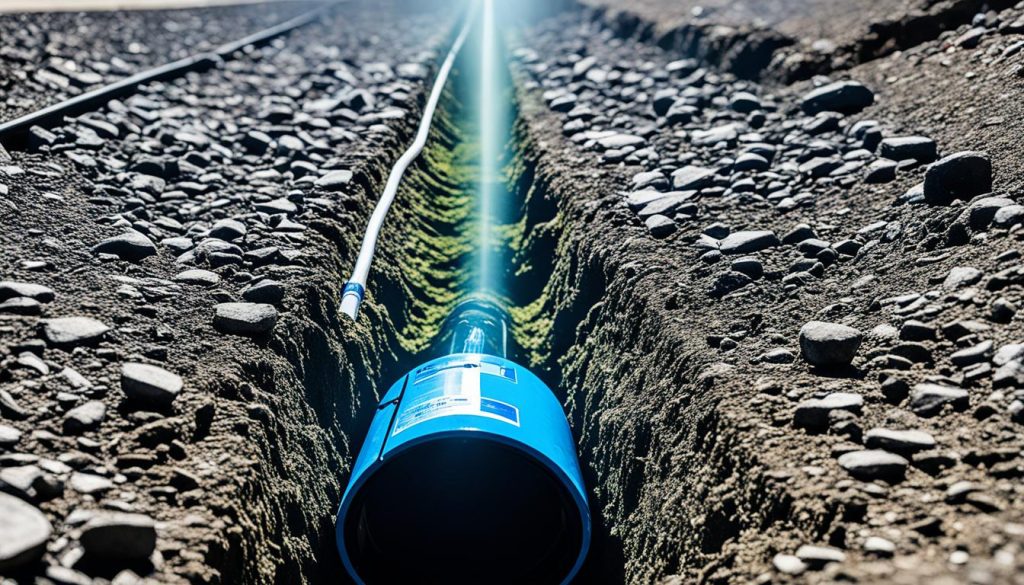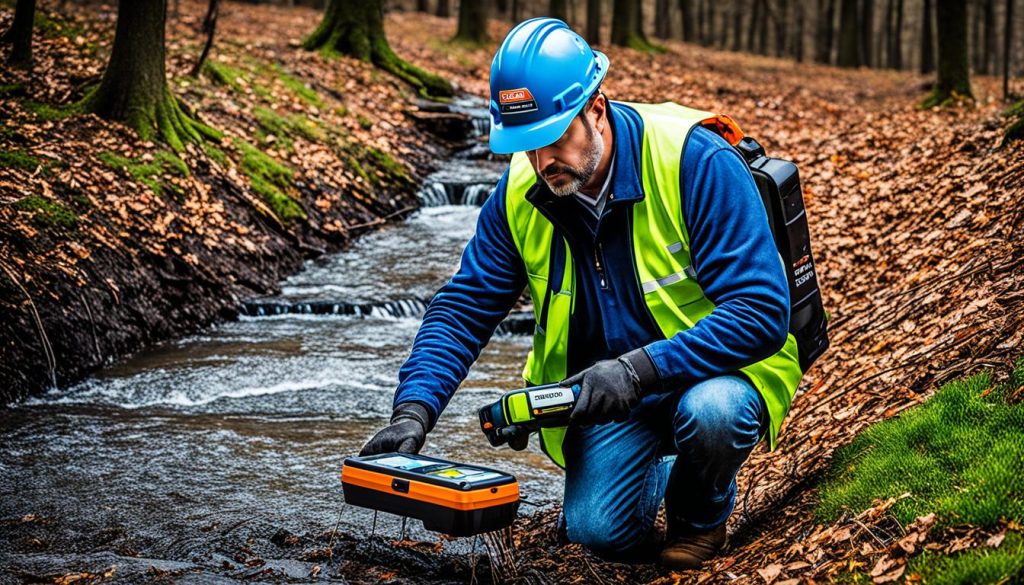Discover How to Find Underground Water Line
Did you know that a staggering 20% of all utility damage incidents in Canada are caused by accidental hits to underground water lines during construction or excavation projects? Locating buried water pipes is crucial to avoid costly repairs and accidents that can lead to flooding and property damage. However, traditional metal detectors may not be effective in detecting modern PVC or plastic water pipes. To accurately find underground water lines, you need to employ specialized methods and tools designed for this purpose.
In this article, I will guide you through the process of locating underground water lines, highlight different detection methods, and recommend some of the best utility locators available in the market. Whether you are planning a DIY project or working in a professional capacity, understanding how to find underground water lines is essential for a successful and safe excavation or construction.
Key Takeaways:
- To avoid costly repairs and accidents, it is crucial to locate underground water lines before engaging in any construction or excavation work.
- Traditional metal detectors are not suitable for detecting modern PVC or plastic water pipes.
- Methods such as acoustic detection, ground penetrating radar (GPR), electromagnetic conductivity (EM), and ultra-high radio frequencies can be used to locate underground water lines.
- Recommended utility locators for finding underground water lines include Pipehorn 800HL, Schonstedt REX, Pipehorn 800H, and Schonstedt Loki.
- Professional utility mapping services, such as SoftDig, can ensure accurate and safe detection of underground utilities.
Steps for Underground Water Pipe Location
When it comes to locating underground water pipes, using a utility locator is the key. By following these simple steps, you can efficiently locate and mark the positions of underground water pipes.
-
Prepare the Utility Locator:
- Read the user manual or instructions provided for your specific utility locator model.
- Set up the utility locator according to the manufacturer’s guidelines.
- Ensure that the locator is properly calibrated and functioning correctly.
-
Aim and Walk:
- Hold the utility locator at a comfortable height and angle.
- As you walk slowly, keep the device pointed towards the ground.
- Pay close attention to any visual or audible indications from the utility locator that suggest the presence of an underground water pipe.
-
Mark the Pipe Locations:
- Whenever the utility locator detects an underground water pipe, use your preferred marking method to indicate its location.
- Consider using brightly colored flags, spray paint, or any other suitable markers that will be easily visible.
- Make sure to mark each pipe location accurately to avoid confusion during any future excavation or construction work.
Following these steps will help you confidently locate underground water pipes using a utility locator and ensure that you have an accurate reference for any necessary digging or maintenance work.
Note: The table below provides a comprehensive comparison of some popular utility locators available in the market:
| Utility Locator | Features | Price |
|---|---|---|
| Pipehorn 800HL | Dual-frequency performance Highly recommended for tough conductors |
$1,500 |
| Schonstedt REX | Lightweight and portable Multi-frequency detection capabilities |
$1,200 |
| Pipehorn 800H | Precision pinpointing Can detect utility lines buried up to 18 feet deep |
$1,800 |
| Schonstedt Loki | Advanced features for quick sweeping Includes frequency selection and sonde detection |
$2,000 |
Different Methods for Finding Underground Water Lines
When it comes to locating underground water lines, there are several methods available. Each method has its own advantages and considerations, offering different levels of accuracy and effectiveness. Understanding these methods will help you choose the most suitable approach for your needs.
1. Acoustic Method – Locating Subsurface Locations
The acoustic method is a traditional approach that utilizes branches or rods held over the ground to detect subsurface locations based on their movements. This method relies on the principle that the sound or vibration created by water flowing through an underground pipe can be detected above the ground. While some question its accuracy, many professionals find it to be a reliable technique for locating underground water lines.
2. Ground Penetrating Radar (GPR) – Radar Technology for Comprehensive Detection
The ground penetrating radar (GPR) method relies on radar technology to locate both metallic and non-metallic objects underground, including water lines. This advanced method requires additional steps, such as removing the hydrant’s cap and placing a leak detection device. However, GPR can provide comprehensive detection and accurate mapping of underground water pipes, making it a valuable tool for professionals in the field.
3. Electromagnetic Conductivity (EM) – Detecting Metallic Pipes
The electromagnetic conductivity (EM) method is a specialized approach for locating underground utility lines, including metallic pipes. It operates on the principle that different materials conduct electricity differently. By measuring the electromagnetic conductivity of the soil, this method can identify the presence of metallic pipes. However, it may not detect non-metallic pipes, such as those made of PVC. EM is more expensive compared to other methods, but it can be an effective solution for finding metallic water lines when used correctly.
4. Ultra-High Radio Frequencies – Effective in Diverse Soil Conditions
Using ultra-high radio frequencies, this method is particularly effective in wet soil, snow, clay, or standing water. A hand-held device is swept over the ground, reading different indicators to locate underground water lines. Ultra-high radio frequencies can penetrate various soil types and provide reliable results, making it a versatile method for water line detection.
| Method | Advantages | Considerations |
|---|---|---|
| Acoustic Method | Reliable for many professionals Simple and cost-effective |
Questioned accuracy |
| Ground Penetrating Radar (GPR) | Comprehensive detection Accurate mapping of underground pipes |
Requires additional steps |
| Electromagnetic Conductivity (EM) | Detects metallic pipes Can be effective for utility lines |
May not detect non-metallic pipes More expensive |
| Ultra-High Radio Frequencies | Effective in diverse soil conditions Reliable results |
– |
Recommended Underground Utility Locators
When it comes to locating underground utility lines, having the right tools can make all the difference. Here are some of the best utility locators in the market:
| Utility Locator | Description |
|---|---|
| Pipehorn 800HL | This dual-frequency utility locator is highly recommended for finding underground pipes and cables. With its superior high-frequency performance, it can detect tough conductors commonly found in various industries. |
| Schonstedt REX | Professionals in utility-related industries often rely on the Schonstedt REX. This multi-frequency pipe locator is lightweight, portable, and capable of detecting different frequencies, making it versatile and efficient. |
| Pipehorn 800H | For precise pinpointing, the Pipehorn 800H is an excellent choice. It can locate utility lines buried up to 18 feet deep (depending on soil conditions and signal conductivity), offering durability with its high-impact ABS housing. |
| Schonstedt Loki | The Schonstedt Loki is designed for sweeping large areas to quickly locate buried assets. It comes equipped with advanced features such as frequency selection, sonde detection, and noise protection. |
These recommended utility locators are trusted by professionals and provide reliable and accurate results. Whether you are a contractor, landscaper, or homeowner, having the right tools can help you efficiently locate underground utility lines and avoid potential damage to infrastructure.
Importance of Locating Underground Water Lines
Locating underground water lines is crucial in order to prevent damage to your property and avoid costly repairs. Accidental hits to water lines during digging or construction work can result in flooding and significant financial consequences.
By utilizing effective methods and tools to locate underground water lines, you can greatly reduce the risk of such incidents. This proactive approach allows you to identify the precise location of water lines before starting any excavation or construction project, enabling you to plan and execute the work with utmost care and precision.
One cost-effective prevention measure is to consider professional utility mapping services, such as SoftDig. These services provide accurate and reliable detection of underground utilities, including water lines, using advanced technologies and experienced personnel.
Thorough planning, in combination with adherence to safety practices and utilizing utility mapping services, ensures the accurate and safe detection of underground utilities, reducing the potential for accidents, damage, and costly repairs. Whether you are a homeowner or a contractor, investing in the proper detection of underground water lines is a crucial step in any digging project.
- Investing Wisely: How Windows & Doors in Boost Property Value and Financial Health - April 24, 2025
- The Financial Impact of Personal Injuries: Why Legal Help Matters for Business Owners - April 16, 2025
- The Hidden Financial Costs of Domestic Assault: What Business Owners Need to Know - April 16, 2025














